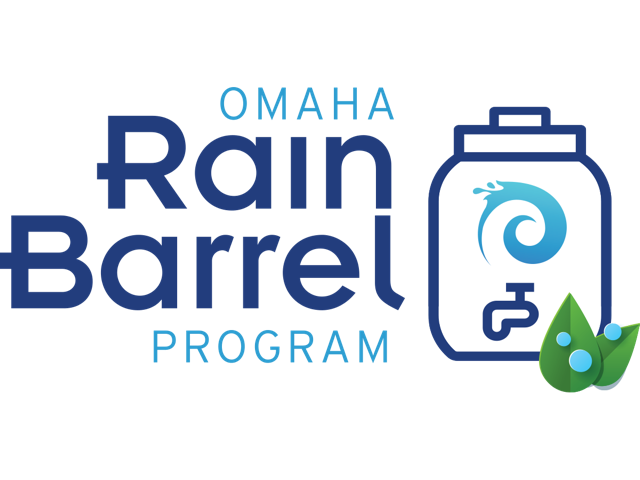Rain Barrels

Why use a Rain Barrel?
Rain barrels collect and store rainwater from rooftops to use later for watering trees, plants and gardens. Water collected in a rain barrel would normally drain off your roof and become stormwater runoff. They’re inexpensive and easy to build and install. Rain barrels can also be arranged to slowly release the collected rainfall to areas that can soak up the water, reducing stormwater runoff and protecting water quality. For more information, check out our fact sheet and rain barrel brochure below.
Omaha Rain Barrel Program
UPDATE 10/31/25: Our barrel give-away is closed until further notice. Stay tuned for any updates in the future!
In 2023 a local manufacturer, American Labs (ALI) donated 55-gallon plastic barrels to Keep Omaha Beautiful and the City of Omaha in order to repurpose a resource rather than simply dispose of them. In April 2024 at Earth Day Omaha the free rain barrel program was restarted in order to distribute the donated barrels. The effort is going to be handled in a similar way as the previous efforts.
In 2010 and 2012 the Omaha Stormwater Program created the Omaha Rain Barrel Program which gave away food grade barrels that were donated by Coke-a-Cola to create rain barrels. An informative brochure was created to support citizen with building their rain barrels. The brochure includes a list of parts and a step-by-step instruction guide. Unfortunately, the donation of the barrels from Coke-a-Cola ceased after 2012, and we focused on educating interested citizens and organizations about rain barrels and how to create one.
Rain Barrel FAQs
Is there any maintenance required?
The screened lid on your rain barrel is designed to keep debris from entering the barrel. Monitor your rain barrel, keep the screen clear of debris, and clean on an as-needed basis.
How do I clean the barrel?
Rinse your barrel occasionally to remove small amounts of fine debris and organic material. Depending on the assembly method used during building your rain barrel, e.g. caulking or sealant was not used during construction, you may be able to remove the spigot assembly to purge larger particles of debris that may have entered, (this is a good time to thoroughly clean the assembly). A safe cleaning solution is 2 teaspoons of castile soap and 2 teaspoons of vinegar per gallon of water, or 2 teaspoons of lemon juice per gallon of water in the barrel. Empty the water into your landscaping – the diluted cleaning product should not harm your plants or lawn. Note: If the water is used frequently, cleaning is rarely necessary.
How long can water be stored?
Some sources recommend no more than seven days, while others say it can be stored indefinitely. If you use it frequently, you’ll have more storage room available for the next rain.
Are mosquitoes an issue?
Possibly, although your rain barrel’s screened lid is designed to keep mosquitoes out. As a precaution, use the water from your barrel often. Non-toxic products can also be added to the water as a further precaution to kill mosquito larvae.
What about algae?
Plants don’t mind algae, but it could clog the spigot. Depending on the assembly method used when building your rain barrel, remove and clean the hose assembly, or use a pipe cleaner to dislodge and remove stubborn algae from the hose assembly.
Is it safe to use water from my rain barrel on a vegetable garden?
Asphalt-shingle roofs and flat tar roofs may leach complex hydrocarbon compounds that should not be used on plants meant for human consumption. Depending upon the makeup of your roof, and whether your gutters and downspouts contain lead paint, water from your rain barrel may not be suitable for vegetables. If you do use the water on a vegetable garden, it is best to use this water for drip irrigation, and avoid using overhead irrigation.
How much rain falls off my roof and how much can I harvest?
If it rains 1 inch in one day, a 1000 sq. ft. roof will yield 600 gallons of water. To calculate how much water your roof will produce, multiply the square footage of your roof by 600 and divide by 1000.
Can I leave the Rain Barrel out during the winter?
Yes, but we suggest that you empty the barrel during a cold snap, and remove the downspout from the barrel to prevent from filling during the winter months. Additionally, the barrel is fairly durable, being made from high density polyethylene, but the brass spigot and/or the PVC plumbing will not hold up to freezing weather very well and more than likely will crack.
Additional notes:
- DO NOT DRINK water from your rain barrel! The water is non-potable, and may contain animal droppings, dust, roof composite, or other pollutants.
- Locate your rain barrel on firm, level ground, at a higher location than the area you intend to water. You can place the barrel on a concrete paving stone, bricks, or cinder blocks.
- Do not place the barrel where it may allow an intruder to gain access to your home, such as under a window or balcony.
- Follow the rules of your HOA or local covenants regarding the installation and placement of a rain barrel.
- Do not direct overflow to your neighbor’s property.
Still have questions?
Contact us at 402-444-3908

